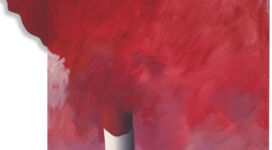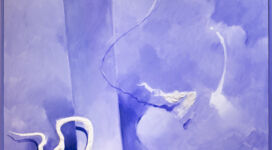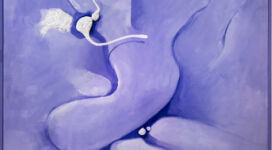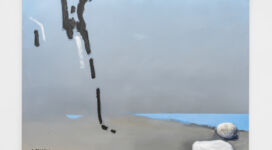| COSTAS TSOCLIS | Exhibition 2024 | |
| Close up 2019 |
Costas Tsoclis was born in 1930 in Athens where he spent his teenage years. Son of an amateur painter, he had been interested in art since he was a child, over time coming to practise all the disciplines of the visual arts. Between the age of 10 and 15, he lived under the threat of the Second World War and German occupation, followed by civil war and the desperate struggle for survival. Nevertheless, he pursued his curiosity for art, working as an assistant in the workshop of Stephanos Almaliotis from the age of 12 to 18, and creating film posters and props with Vangelis Faenos. In 1948, he enrolled at the Academy of Fine Arts in Athens where he studied with Yannis Moralis until 1954. Three years later he won a Greek state scholarship and went to Rome, where he studied the art of frescoes and encaustic at the School of Ornamental Arts. He created the Sigma Group with fellow artists Vlassis Caniaris, Nikos Kessanlis, Dimitris Condos and Yiannis Gaitis. Based in Rome, the main aim of the group was to create a support network for Greek expatriate artists.
At the age of 24, he was conscripted for two years in compulsory military service, during which time he still managed to paint.
Under the influence of artists Afro Basadella and Alberto Burri, Tsoclis developed an initial language whose abstract gestures used industrial and/or low-cost materials such as concrete, coal and straw in an attempt to highlight the intrinsic plasticity and consistency of his art. In 1957, he married Fania Kaplanidou to whom he is indebted for the support she gave him until her death in 1968 and giving him his only daughter Maya. They lived together for eleven years, in Rome and Paris. Moving to Paris in 1960, he stayed there for over 20 years. Here his artistic language evolved, gaining recognition in artistic circles. He signed a contract with the gallery of Ileana Sonnabend. His work also met with success in Belgium, Italy and Germany, with some important exhibitions in his name. During this period, among others, he started to work with art critics José Pierre and Pierre Restany, with whom he became friends. In 1966, he introduced the first “objects” into his works, partially inspired by trompe l’oeil. In 1971, he moved to Berlin where he lived with his assistant and love of his older years, Eleni, and daughter Maya. During this decade, he used everyday objects (e.g., crumpled paper between 1970 and 1975), coming to introduce new fundamental subjects such as trees and seascapes in 1978. These works feature physical objects alongside the painted elements on the canvas.
In 1972, he went back to Paris, where he met gallery owner Alexandre Iolas, in whose galleries, in Athens, Paris and New York, he held important solo shows between 1973 and 1976. Eleni and Maya came back to Athens in 1973, and Tsoclis went back and forth between Paris and Athens for 12 years. During this time, his stays in Greece got longer and longer, and he moved back for good in 1985. In this period, he started to experiment with video in his painting, in multimedia works that were chosen to represent Greece at the Venice Biennale in 1986. A pioneer in the field, Tsoclis can be considered the inventor of living painting.
Tsoclis exhibited his works in countless solo shows at: Palais des Beaux-Arts, Brussels (1971); Kunsthalle, Dusseldorf (1972); Pinacoteca Pierides, Athens (1983); Greek pavilion at the Venice Biennale (1986); Macedonian Centre of Modern Art, Thessaloniki (1988); P. & M. Kydonieos Foundation, Andros (1995); Palazzo delle Esposizioni, Rome (1996); Centro Rocca Paolina, Perugia (1996); Stoa of Eumenes (Acropolis), Athens (1997); Astrolavos Gallery, Athens (1998, 1999, 2008); Lola Nikolaou Gallery, Thessaloniki (1999, 2002, 2006); Liturgia, Centro per l’arte contemporanea L. Pecci, Prato (2000); Costas Tsoclis – Retrospective, National Museum of Contemporary Art, Athens (2001); Palazzo Strozzi, Florence (2003); Benaki Museum, Athens (2006); Monastiria, Tinos (2006); European Cultural Centre, Delphi (2006); Ancient Theatre of Philippi, Kavala (2007); Skolion, Piraeus, Athens (2009).
The group exhibitions he has participated in include: Paris Biennale (1963 and 1965); São Paulo Biennale (1965 and 1967); Moderna Museet, Stockholm (1970); Documenta, Kassel (1977); Europalia, Brussels (1982); FIAC, Paris (1989); Seoul International Art Festival, Seoul (1990); “Cultural Capital of Europe”, Copenhagen (1996); Metropolitan Museum of Photography, Tokyo (1998) and Tel Aviv Museum of Art, Tel Aviv (1998).
In 2011, the Costas Tsoclis Museum was founded in the municipality of Kampos on the island of Tinos, Greece. Director Chrysanthi Koutsouraki has curated exhibitions of various periods of his work (2017 and 2022).















